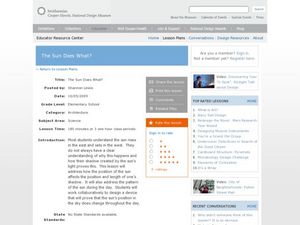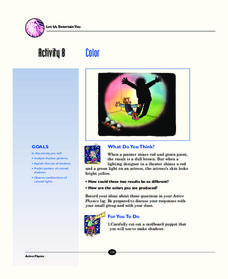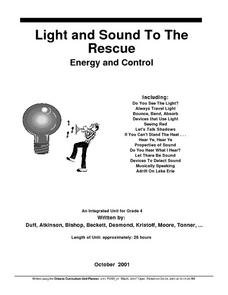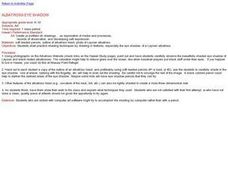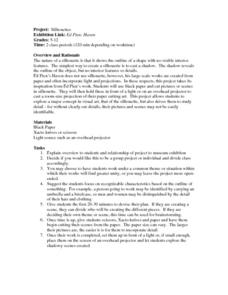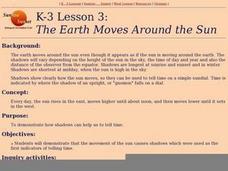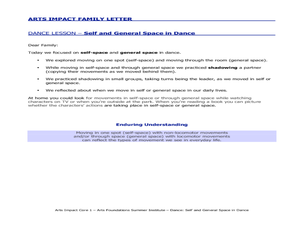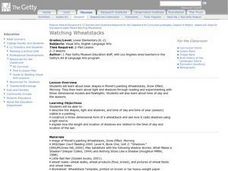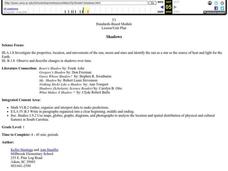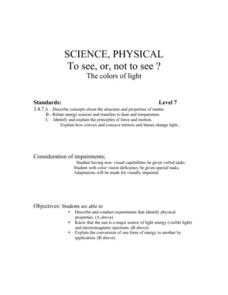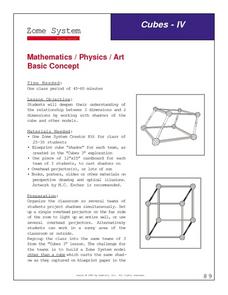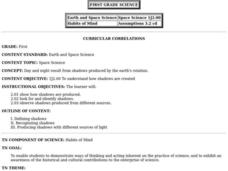Curated OER
The Sun Does What?
Students examine why the sun rises in the east and sets in the west. In this sun lesson, students explore the sunset and shadows. Students prove that the sun's position changes during the day. Students investigate what causes a shadow....
Curated OER
Winter is All Around Us
Students present what they have learned on Antartica. Students identify deciduous and evergreen trees and plants; identify and study about the habitats of animals that migrate, hibernate, and adapt; study the Aurora and Aurora Borealis...
It's About Time
Color
How can a hand puppet's shadow look like a dog? The lesson explains the science behind shadows, combining paint colors and the colors used in old televisions. Scholars use white, red, blue, and green lights to experiment with colors and...
Scholastic
Groundhog Day
A simple activity for a simple, but special, holiday. Young learners read a brief history of Groundhog Day, practice reading aloud, and then discuss how shadows are formed.
Curated OER
Light and Optics
Third graders utilize the scientific method to explain light and optics in this five lessons unit. Through experimentation and discussion, 3rd graders canvass the concepts of light traveling, reflection and refraction.
Curated OER
Light And Sound To the Rescue
Fourth graders use the design process to construct devices that send distress signals through air and water for purposes of rescue. They construct devices that use light and sound to assist in nautical rescues and use the knowledge...
Curated OER
The Shadow Knows
Sixth graders examine the relationship between light and the angle it strikes objects. In groups, they shine light from a flashlight on different objects and describe how it affects the shadow. To end the lesson, they complete a...
Curated OER
How Does Light Travel?
Sixth graders are read The Way to Start a Day by Byrd Baylor or Bear Shadow by Frank Asch. They discuss how the sun affects their daily life, 6th graders are encouraged to think about the light we recieve from the sun and how man has...
Curated OER
Cloud Shadows
Students classify the visual opacity of various materials, what is needed to create shadows, and classify clouds by the types of shadows that they produce.
Curated OER
Sunshine and Shadows
Students measure their shadows early in the morning, record direction of shadow, make marks in ground with chalk or tape, measure with ruler, and record results. Students repeat process at noon, and then later in afternoon. Students...
Curated OER
Learning Lesson: The Shadow Knows I
Students examine the elevation of the sun to discover the changes in seasons. They observe and measure the length of their shadow. They compare this measurement to one taken four months later.
Curated OER
Albatross Eye Shadow
Students practice shading techniques to mimic the exquisite shading of the Albatross eye (eye shadow). Extension for students skilled in computer art included.
Curated OER
Silhouettes
Students explore the challenges of creating a silhouette. In this silhouette lesson, students learn to produce a silhouette from a projected image. Students compare and contrast the making of a silhouette to a drawing or painting.
Curated OER
The Earth Moves Around the Sun
Students demonstrate that the movement of the sun causes shadows which were used as the first indicators of telling time.
Curated OER
Self and General Space in Dance
Students explore the different themes and strategies of dancing by performing in class. In this physical education lesson, students practice moving specific joints and muscles as they train to perform a dance. Students perform a dance...
Curated OER
Watching Wheatstacks
Young scholars explore basic shapes in Monet's paintings Wheatstacks, Snow Effect and Morning. They study about light and shadows through reading and experimenting with three-dimensional models and flashlights.
Curated OER
Colored Shadows
Young scholars examine how humans perceive color. In this refracted light activity, students explore the different ways color is seen by the human eye. Young scholars will use colored lights and colored paper and solid objects to make...
Curated OER
Shadows
First graders measure how a shadow changes over the course of a day. They write about what they would do if they lost their shadow, and make silhouettes of themselves. Students make up a shadow dance and read stories about shadows.
Curated OER
What things let Light Pass Through?
Second graders classify objects according to how well light can pass through them and predict how well objects will transmit light. They experiment with objects to verify predictions while collecting, recording, and interpreting data...
Curated OER
To See or Not to See: The Colors of Light
Seventh graders describe and conduct an experiment that identifies the physical properties of light. They explore sources of visible light and an electromagnetic spectrum. Students explain the conversion of one form of energy to another.
K20 LEARN
It’s Raining Whats and Whats? Colloquial Language
"Yuns betta outten the lights!" Colloquial language is the focus of a instructional activity that asks middle schoolers to consider the pros and cons of using idioms. They read articles, match expressions with their meaning and place of...
Curated OER
Cubes-IV
Students examine the relationship between three dimensions and two dimensions by working with shadows of cubes and other models. Students work in groups and use Zome System Creator Kits to try and build a shape other than a cube that...
Curated OER
Day and Night
First graders study that day and night result from shadows produced by Earth's rotation. Students work to show how shadows are produced, look for and identify shadows and observe shadows produced from different sources.
Curated OER
Individual Sundial (Cloud/Rain Activity)
Students make a simple sundial to examine the changes in shadows over time. In this sundial and shadow instructional activity, students make a simple sundial out of a manila folder and pencil. They observe how shadows change over time,...


